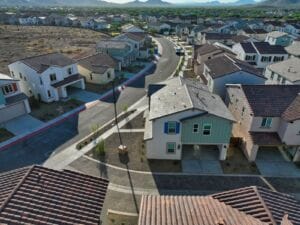The Arizona development industry knows that being water conscious is crucial to the future of construction in the state and has already taken steps to be good stewards of this precious resource, according to Cheryl Lombard, president and CEO of Valley Partnership.
DEEPER DIVE: Here’s the truth about the Arizona water supply
“There’s a commitment to conservation from every aspect of development,” she says. “I don’t care if it’s an industrial facility, a shopping center, an office building or a master-planned community, we have to show how we are efficient and conservation minded.”
Here are two Arizona projects that combine water conservation and responsible development as a guiding principle.
Verdin
Located in North Phoenix, Verdin is a 473-acre master-planned community that seeks to embrace its desert surroundings. Robert Johnson, vice president of land planning and development for Taylor Morrison, notes that Verdin is atypical because it is on one of the only pieces of private property in the Sonoran Preserve area.
“What we’re looking for to is a unique project that will have a natural desert feel that’s sensitive to the surrounding wildlife and to water conservation,” he says.
To balance Arizona water concerns with development, the landscaping will stay as natural as possible, with some areas remaining completely untouched by the developer and others using a specific selection of Sonoran Desert plants, though about 20% will be generally drought resistant vegetation. The only shared spaces that have grass are in small parks, but Johnsons says that even then, there will only be tiny amounts.
“As for our homes themselves, there’s a requirement that you can’t have any grass in the front yard and [residents] have to follow the plant palette for the National Wildlife Federation plant list,” he explains. “The backyards can only have they’ll have to submit for their landscape plans, and then they can only have a maximum of 20% of their backyard be grass.”
To further encourage responsible water usage, the 1,250 homes that make up Verdin will be WaterSense certified. According to the U.S. Environmental Protection Agency’s website, a WaterSense labeled home must be at least 30% more water-efficient than typical new construction.
“[Being certified] entail leak detection audits, along with WaterSense labeled toilets, bathrooms, faucets and showerheads,” Johnson says. “The irrigation systems have to use a WaterSense certified electronic controller, as well as having someone who’s WaterSense certified to design the irrigation system itself.”
These products, Johnson continues, have come a long way in terms of functionality so homeowners don’t have to sacrifice functionality for water savings.
“When manufacturers were just figuring things out, they would just put a restrictor in that limits the amount of water that goes through the faucet or the spray head, and it just cut back on the volume water going through but wasn’t designed for that lower flow, so it just didn’t feel adequate.”
ECO Mesa
For Tim Sprague, a founding principal of Habitat Metro, green development is not a gimmick, fad or trite selling point.
“I have seven grandkids. If we don’t start doing something about building things sustainably, this world is going to be very different for them,” he says.
ECO Mesa is a 102-unit apartment complex that helps residents reduce their carbon footprint with sustainability-focused features. A water catchment system captures greywater to irrigate the landscape rather than using potable water.
Sprague explains that the complex was designed from the inside out to ensure it is as efficient as possible. The insulation used and components chosen for the outside of the apartments are carefully chosen to reduce energy consumption.
“We want to make sure that the building doesn’t leak air. If it’s insulated well, and you’re using materials that literally make it not leak, the amount of energy used is reduced in a meaningful way. If you’re adding solar to the source of energy for the building, the whole thing combined just makes a much more sustainable building,” he says.
Even how the construction supplies arrive on site is considered. “We try to source materials that are that are close by and won’t produce a large carbon footprint. We want to make sure that they are not what we call redline materials, which affect the air quality inside the unit. It goes all the way from plywood to insulation,” Sprague explains.
Having the right people who embrace the philosophy behind ECO Mesa, from consultants to construct workers, is paramount, according to Sprague. “It’s also important to make sure that the management of the facility itself is done by folks that will pay attention how the building is run. We want to make sure that we planned to build continues on after it’s finished,” he says.
Sprague concludes, “We want to set an example of how you can build something sustainable within economic reason. When we finish, we will share all of what we’re doing with everybody else. And the reason why we will do that goes back to what I said about my grandkids. The future is important. Hopefully, we can contribute in a small way and help educate a little bit. If we can do that, we’re happy.”




